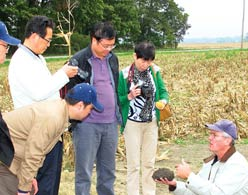BROWNSBURG, Ind. — Cover crops, no-till farming and more responsive nutrient management are key to farming in central Indiana and continue to be of much interest to representatives of other countries such as China.
|
|
A six-member Chinese delegation hailing from Beijing joined Liu Zhen, the director general of the department of soil and water conservation in MWR, embarked on a tour of farms and farm organizations in Indiana recently to learn how conservation is implemented and how it can benefit the soil.
One of their stops was the Starkey Farm in Brownsburg, Ind., where they observed the benefits of no-till farming, observed a water control structure in a bio-swale and talked to officials from the Natural Resources Conservation Service.
The equivalent to a national agency chief in the U.S., Liu sought to lead his delegation to learn how the U.S. Department of Agriculture’s Agricultural Research Service contributes to NRCS technology development and how conservation takes places at the national, state and local levels.
“In China, we have a very different agricultural situation and different tillage practices. We are learning something new here,” he said. “In China, there is a lot of sloped farm land, whereas here in the U.S., there is only flat land. There is also a different farm scale. In China, land is very limited and farmers work on tiny pieces of land.”
“We have been using soil conservation practices for 10 years, but we still want to improve,” he added.
Liu said he believed that no-till farming is a very useful way to preserve water, nutrients, and soil fertility and was impressed with the collaboration taking place between U.S. scientists and conservationists.
“No-till could be applied in some areas of China and is very impressive, but it must be combined with agricultural machination, development and the skill of farming,” he said.
“We feel that farmers really benefit from their suggestions, and we think we can apply no-till in northwestern China in the black soils in the lowest plateau area,” he said. “We still face a challenge in persuading farmers because they have been plowing and using older methods.”
Northeastern and northwestern China are the most productive parts of the country. The USDA’s Foreign Agricultural Service projects that China will produce 5.83 tons of corn per hectare — about 90 bushels of corn per acre, though worldwide yield estimates are down due to the drought.
The delegates spent two days in Indiana, visiting the NRCS field office in Auburn in DeKalb County, where they viewed how current farm practices are compared to proposed practices and learned how conservation practices have been delivered to farmers.
They traveled to NRCS headquarters in Washington the following day to meet with NRCS chief Dave White.
“This is the group’s fourth trip to the U.S., but it’s their first real look at soil and water conservation,” added Chi-hua Huang, a scientist working for the ARS’ National Soil Erosion Research Lab at Purdue University.
“The scale of farming and machinery are the most important factors in farming in China,” Chi-hua added. “They are wanting to start with the northwest part, which is much bigger than central China. The challenge is giving up the machine or not using it as much.”
A difficult aspect of Chinese farming is the lack of mechanization, leading to intensive manipulation of the land before production.
Northeastern China, which is farmed on a large scale akin to the Ukraine, has lost much of its breck soil due to plowing, Chi-hua said.
“It is also a region of China where grain is produced to export to other parts of China,” he said. “In the grain basket of China, agriculture is most important for security, so it is very important to make sure production there is secure and strong.”
Bob Barr, a research scientist with the Center for Earth and Environmental Sciences at Indiana University-Purdue University Indianapolis, explained to the visitors how conservation officials installed a bioswale retention area to capture the tile drain and note how much water was being held in the soil.
A bioswale can be quite expensive to install, so it is all about evaluating which system works best, he added.
Mike Starkey, who has added filter strips, waterways and cover crops to his operation and is in his second year in the Conservation Stewardship Program, said it’s a great year for visitors from around the world to see how clean water and healthy soil can benefit even in trying times such as drought.
Though the farm has witnessed corn yields that are half as low as the farm’s average this year and expect below-average results on soybeans, he said modern conservation practices have enabled him to continue farming.
“I wouldn’t be farming today if I did not no-till,” Starkey said. “The soil gets better every year within this system. The next paradigm in no-till is cover crops, and we’ve got to get the word out, because when they’re managed right and we can educate people about their benefits, it’s a great concept.”
The Starkeys use money through a Clean Water Act Section 319 cost-share program through the NRCS to grow a third of their cover crops and finance the rest themselves.
“This is our seventh year using cover crops. We’re growing them on 7,000 acres. There’s actually green cover on the fields over the winter,” he noted. “We use it as a source of increasing organic matter in our soil and to scavenge available nutrients. A grass cover crop will scavenge nitrogen and other nutrients that might be left in the soil and use it for next year’s crop.”







Post a comment
Report Abusive Comment